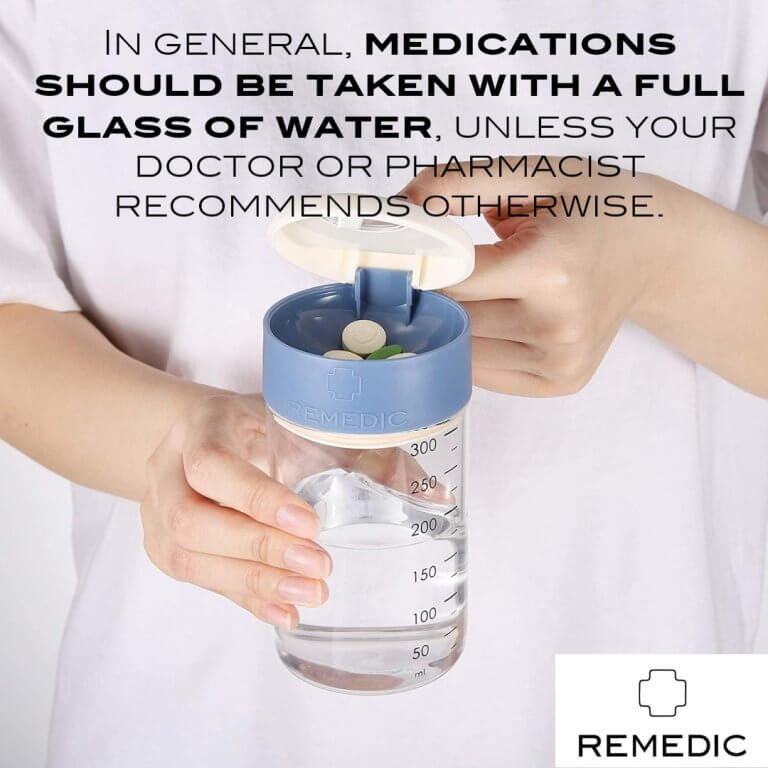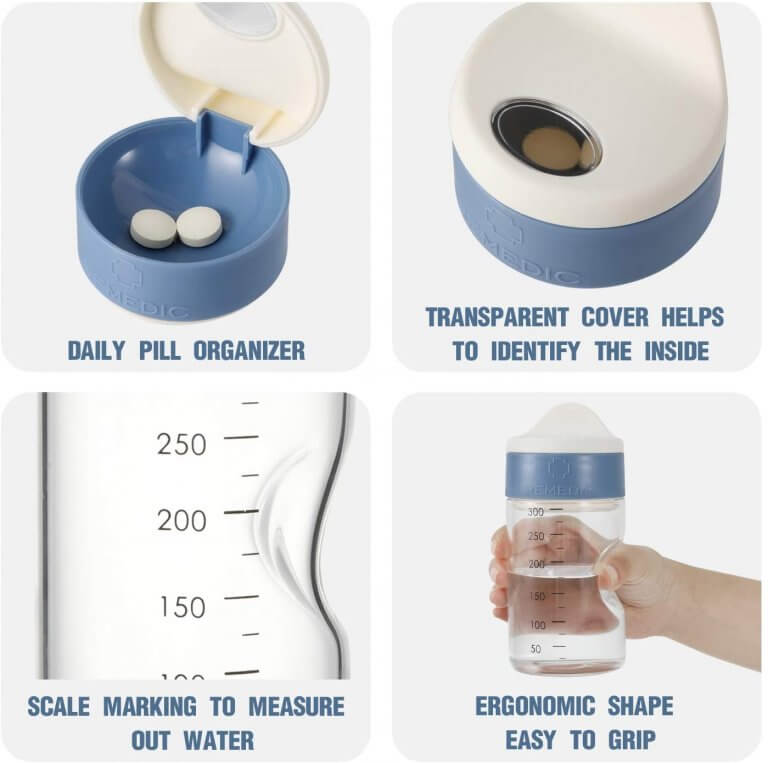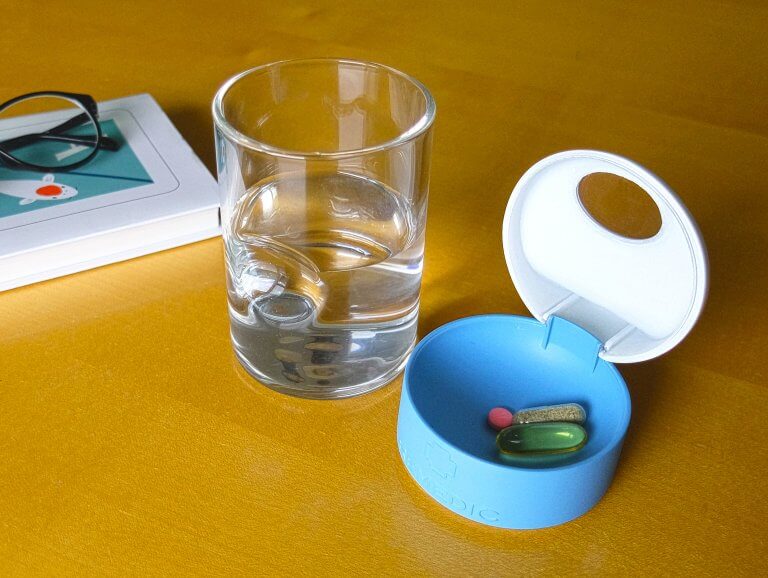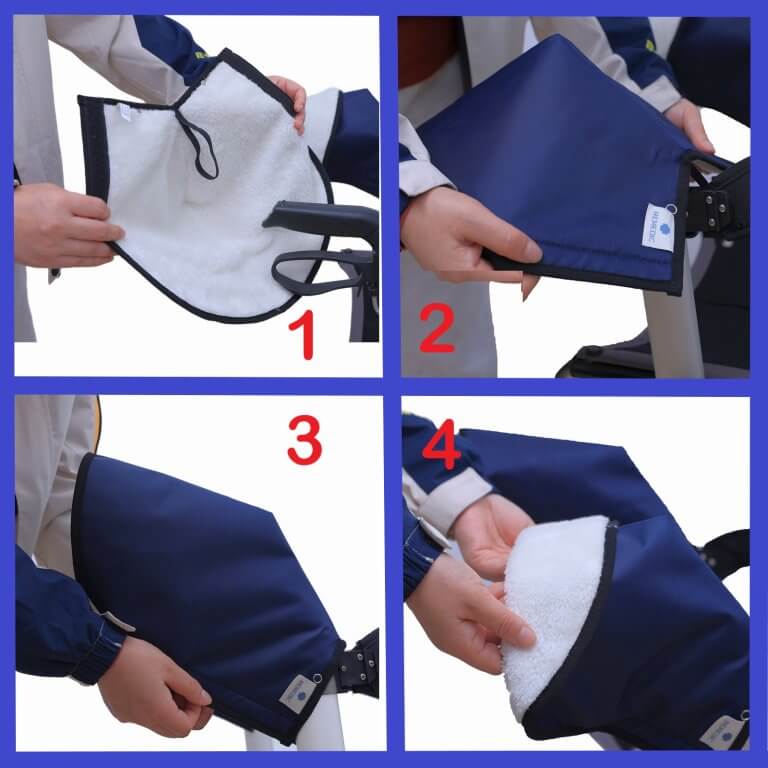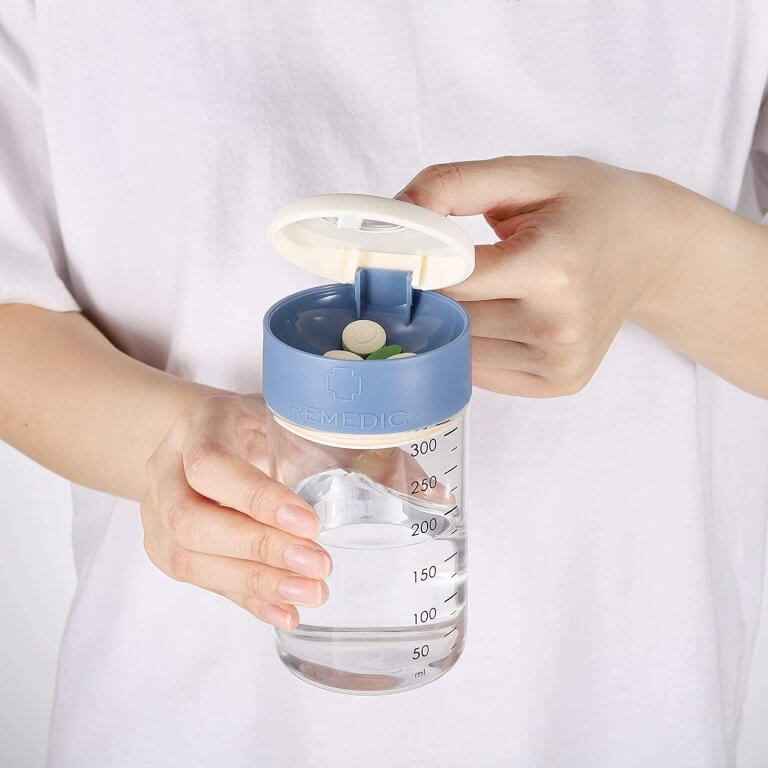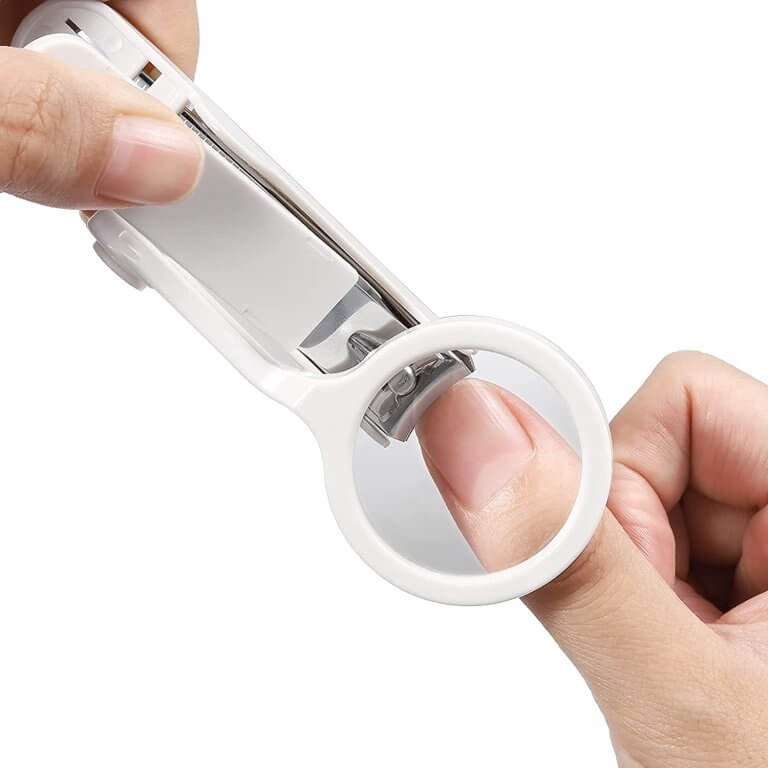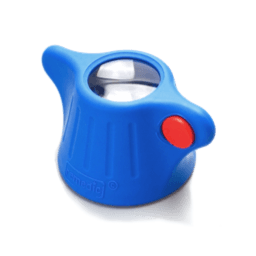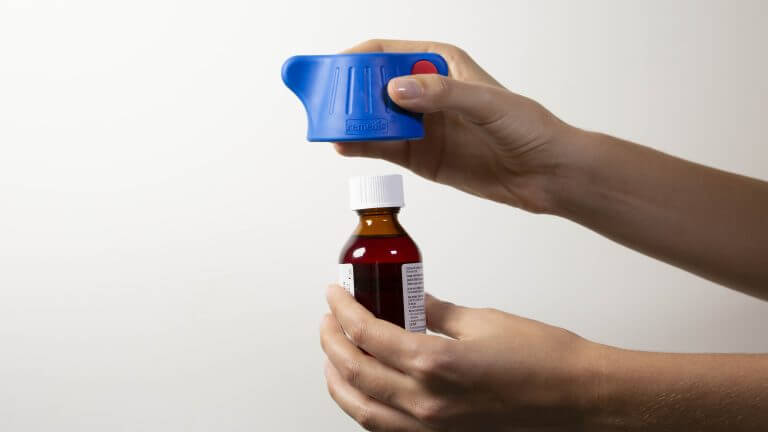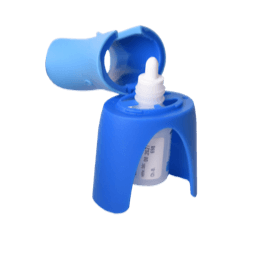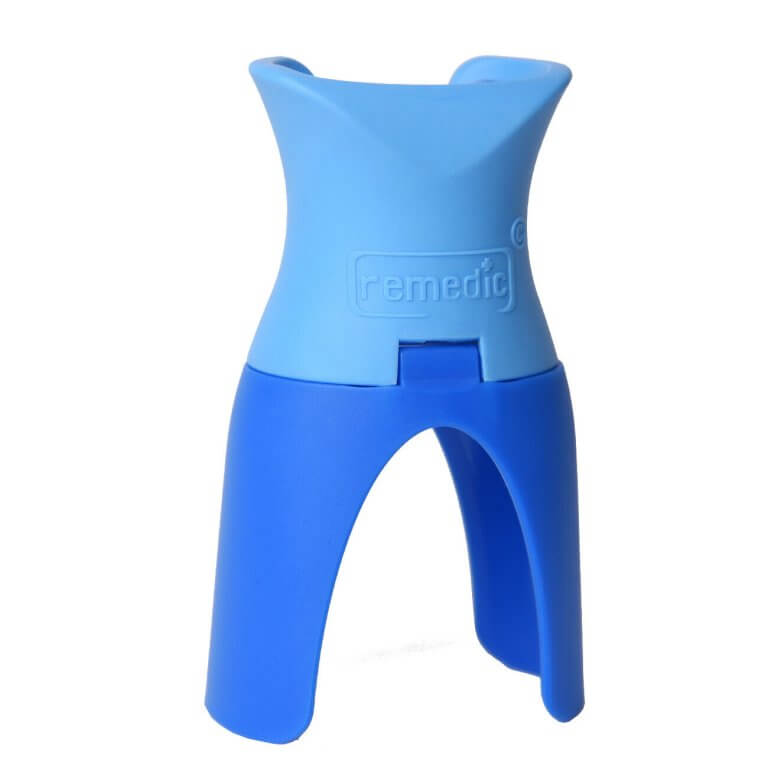Stay on Track with Ease
The Remedic Medicine Cup with Pill Organizer Lid
Taking your daily medications and supplements doesn’t have to be a hassle. The Remedic Medicine Cup with Pill Organizer Lid is here to make your routine simpler, safer, and stress-free. With an easy-grip design, this is the ideal solution for anyone looking to streamline their daily health needs, from organizing pills to ensuring the right amount of water with each dose. Say goodbye to tricky pill bottles and single-use plastic bags—Remedic has thought of everything to make this a perfect choice for folks who value both convenience and sustainability.
Key Features That Make a Difference:
- Pill Organizer Built into the Lid: The Remedic cup combines a water glass and pill organizer into one smart design. The pill box is easily accessible with a simple, tilting lid. No need to struggle with multiple containers—everything is right at your fingertips.
- Arthritis-Friendly Design: With a large, easy-to-open lever on the lid, this cup is crafted to be accessible for anyone with limited hand strength or dexterity. Forget the hassle of traditional pill containers; this design puts comfort first.
- Safe, Easy-Grip Glass: Made with an ergonomic shape, the cup is easy to hold securely, reducing the chance of slipping, even when wet. Made from durable borosilicate glass, it’s ideal for keeping on your countertop for daily use.
- Clear Markings for Water Intake: Medications often require a full glass of water, and with convenient scale markings, you can ensure you’re drinking enough with every dose.
- Quick Visual Check for Meds: The transparent pill box lid allows for a quick glance to confirm you’ve taken your medication—whether it’s a loved one, caregiver, or you checking, it’s easier to stay on track.
- Sustainable and Dishwasher Safe: The Remedic Medicine Cup is designed to be reused, cutting down on waste from disposable plastic bags or cups. Plus, it’s dishwasher-safe for quick and easy cleaning.
The Perfect Companion for Your Daily Routine
This all-in-one solution provides everything you need to make medication and supplement management as smooth as possible. By combining convenience with ergonomic design, Remedic’s Medicine Cup gives you a comfortable, sustainable way to support your health.
Don’t wait to simplify your routine—order the Remedic Medicine Cup on Amazon now and take the first step toward effortless medication management. https://www.amazon.com/REMEDIC-Medicine-Dispenser-Arthritis-Friendly-Easy/dp/B08C53KMN2/
Stay Cozy Outdoors This Winter – with Remedic Rollator Gloves
The Perfect Hand Warmer for Rollator Walkers and Wheelchairs!
Are you ready to enjoy the crisp winter air without cold, uncomfortable hands? With Remedic Rollator Gloves, you don’t have to sacrifice warmth or comfort on your outdoor adventures. Designed specifically for rollator walkers, and wheelchairs, these gloves provide cozy, hands-free warmth, making them a must-have accessory for anyone using mobility aids in cold weather.
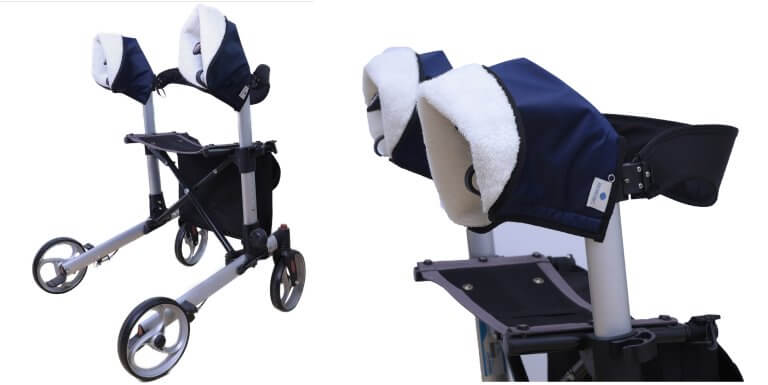
Ultimate Winter Warmth for Outdoor Walks and Errands
Imagine stepping out for a walk, heading to the store, or visiting friends, all while keeping your hands warm and comfortable. The Remedic Rollator Glove features a water-resistant outer shell that shields your hands from rain, snow, and wind, paired with a luxuriously soft faux fur lining that adds a layer of gentle, cozy warmth. Whether you’re out for a stroll or running errands, these gloves provide the comfort and protection you need during colder months.
Easy, Secure Attachment for Hands-Free Convenience
Unlike traditional gloves, which you constantly need to put on and take off, the Remedic Rollator Glove stays securely attached to your mobility aid. An adjustable hook-and-loop fastener allows the gloves to fit easily and stay fixed on the handles of rollator walkers, and wheelchairs. This hands-free design means you won’t have to worry about misplacing your gloves, freeing you to focus on enjoying your outing.
Perfect for Temperature-Sensitive and Arthritic Hands
Cold weather can be especially tough for people with temperature-sensitive or arthritic hands. The Remedic Rollator Glove is designed with these challenges in mind, offering soothing warmth that helps alleviate discomfort and keeps hands relaxed, even on the coldest days. For older adults or anyone who experiences hand pain in colder temperatures, these gloves provide a practical, comforting solution.
Key Benefits of Remedic Rollator Gloves
- Hands-Free Warmth – Forget about taking gloves on and off. The Remedic Rollator Glove stays securely attached to your rollator, walker, or wheelchair, keeping your hands warm without restricting movement.
- Protection from Rain, Snow, and Wind – Made for all weather conditions, the gloves have a water-resistant outer shell that shields your hands from rain and snow, while the soft faux fur lining ensures maximum warmth and comfort.
- Seniors and Caregivers Love Them – These gloves are ideal for seniors and people with arthritis or temperature-sensitive skin, offering gentle warmth that makes outdoor activities comfortable and enjoyable for older adults.
- Never Lose Your Gloves Again – With the hook-and-loop design, the gloves stay attached to your mobility aid, so you’ll never have to worry about losing them during errands or outdoor strolls.
- One Size Fits All – Designed to fit all models of rollator walkers, wheelchairs, and mobility aids, the Remedic Rollator Glove makes a versatile, thoughtful gift for loved ones who value comfort, convenience, and outdoor freedom.
Made from High-Quality Materials for Style and Durability
Crafted from premium materials, the Remedic Rollator Glove combines durability and style in a sleek dark blue color that matches any mobility device. The high-quality fabric is designed to withstand regular outdoor use, making these gloves an essential winter accessory that’s built to last.
How Remedic Rollator Gloves Make Life Easier
Not only are these gloves designed with the user in mind, but they also make life easier for caregivers. By ensuring warmth and comfort for those with sensitive hands, Remedic Rollator Gloves enable seniors to enjoy greater independence during winter outings. Caregivers can assist loved ones with confidence, knowing that cold hands won’t be an issue.
Customer Satisfaction Guaranteed, with 24/7 Support
At Remedic, customer satisfaction is our top priority. That’s why we offer 24/7 customer support to answer any questions or address concerns. If you or your loved ones need help with your purchase, our team is here to assist around the clock, ensuring you’re fully satisfied with your Remedic Rollator Gloves.
Don’t Let Winter Weather Keep You Indoors
Don’t let chilly weather keep you from enjoying the outdoors. With Remedic Rollator Gloves, you’ll have the perfect hand warmer to make every outdoor trip cozy and comfortable. These gloves make an ideal gift for elderly friends and family, providing warmth, convenience, and peace of mind for those who cherish their independence.
Order your Remedic Rollator Gloves on Amazon today, and feel the difference in warmth, comfort, and hands-free convenience this winter!
How to Attach the Remedic Rollator Glove to your Walker or Rollator
- 1 – Slide the loop over the handle.
- 2 – Position the glove securely on the handle.
- 3 – Fasten the hook and loop strips on each side of the glove.
- 4 – Fold the glove to your desired length.
This ensures a secure, one-size-fits-all fit for comfort and control.
Medication Safety for Caregivers: How to Prevent Mistakes and Protect Loved Ones
Remedic – Innovative Daily-Living Aids for Every Age and Ability
Caring for someone who takes multiple medications can be stressful. Between managing prescriptions, reading labels, and timing doses, mistakes can easily happen — and even a small error can cause serious harm.
At Remedic, we know that most medication errors are preventable with the right knowledge, tools, and organization. This guide explains how caregivers, family members, and older adults can stay safe and confident when managing medications at home.
in this article you will read about:
-
medication management tips for seniors
-
caregiver medication safety checklist
-
daily-living aids for arthritis and weak grip
Medical Disclaimer: This blog is for informational purposes only and is not a substitute for professional medical advice. Always consult your doctor, pharmacist, or healthcare provider for questions about your medications. In case of an emergency, call 9-1-1.
Medication Safety for Caregivers: Tips for Seniors, Families & Independent Living
🩺 Why Medication Safety Matters
In the U.S., medication errors account for thousands of emergency visits every year. The most common causes include:
-
Mixing up pills or dosage times
-
Confusing similar-looking packages
-
Forgetting to take or refill prescriptions
-
Difficulty opening bottles or reading small labels
These mistakes often happen not from carelessness, but because of overload and unclear instructions. With the right strategy and assistive tools, you can prevent them.
✅ Top Tips for Safer Medication Management
1. Use a Clear Pill Organizer
A weekly pill box helps caregivers and patients see what’s been taken at a glance.
Remedic’s Weekly Pill Organizer features four compartments per day and easy-open lids for arthritis or weak grip. It keeps doses clear and travel-ready.
2. Create a Medication List
Write down all prescriptions, over-the-counter pills, and supplements.
Include dosage, schedule, and purpose. Keep this list in your wallet, smartphone, or with your Remedic pill organizer.
3. Establish a Routine
Take medications at the same time every day — such as during meals or bedtime.
Set reminders on your phone or use Alexa/Google Home voice alerts to keep consistency.
4. Ask the Pharmacist for Help
Don’t hesitate to ask questions about side effects, interactions, or proper storage.
Pharmacists can also print large-font labels for older adults.
5. Use Assistive Tools for Safety
Remedic offers medicine bottle openers with magnifiers and LED lights, non-slip grips, and adaptive daily-living aids to make every task safer and simpler.
Missing or Doubling Doses
Common Errors:
- Skipping doses or accidentally taking extra.
- Forgetting if you already took a dose and taking it again.
Prevention Tips:
- Use a pill organizer to keep doses organized by day and time.
- Set reminders on your phone or keep a medication log.
- Always ask your pharmacist or doctor what to do if you miss a dose to avoid double dosing.
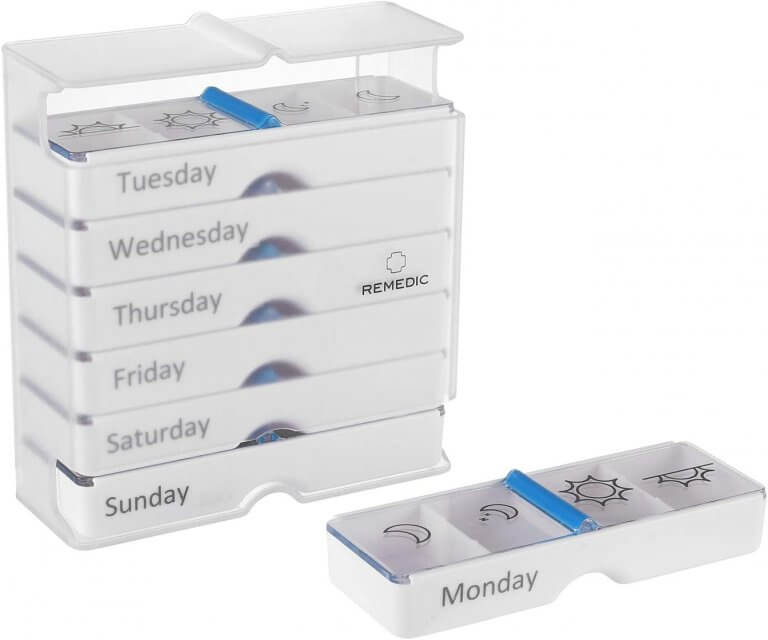
- Mixing Up Medications
Common Errors:
- Confusing medications with similar names, shapes, or colors.
- Taking the wrong medication due to poor labeling or storage.
Prevention Tips:
- Keep a detailed list of all medications, including descriptions, and share it with your healthcare provider.
- Store medications separately and in clearly labeled containers.
- Use a single pharmacy to help reduce the risk of duplicate medications and interactions.
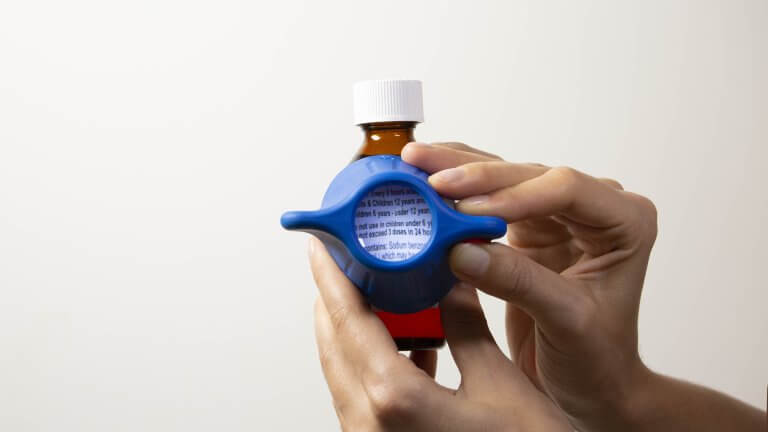
- Taking Medications Incorrectly
Common Errors:
- Taking pills without enough water.
- Incorrectly chewing, crushing, or splitting pills.
Prevention Tips:
- Take pills with a full glass of water unless your doctor or pharmacist says otherwise. This helps with absorption and reduces the risk of stomach upset or throat irritation.
- Ask a pharmacist before splitting, crushing, or chewing tablets, especially if they are marked as long-acting or enteric-coated.
- Food and Drink Interactions
Common Errors:
- Eating or drinking foods that affect medication effectiveness, like dairy with antibiotics or grapefruit juice with certain statins.
Prevention Tips:
- Read medication labels and consult your pharmacist about food interactions for each prescription.
- Avoid alcohol with medications that warn against it, and be cautious with caffeine if the medication may increase its effects.
- Storing Medications Improperly
Common Errors:
- Keeping medications in humid or warm environments (like a bathroom).
- Mixing old and new medications in the same container.
Prevention Tips:
- Store medications in a cool, dry place like a drawer or cabinet away from sunlight.
- Dispose of expired medications safely to avoid confusion and reduced effectiveness.
- Not Asking Important Questions
Common Errors:
- Forgetting to ask about side effects, correct usage, or possible interactions.
Prevention Tips:
- Use every pharmacy visit as an opportunity to ask your pharmacist about each medication: its purpose, side effects, and if it should be taken with food.
- Keep an updated medication list and share it with every healthcare provider to help prevent interactions and errors.
- Using Improper Measuring Tools
Common Errors:
- Using kitchen spoons to measure liquid medication instead of a proper measuring tool.
Prevention Tips:
- Always use the measuring tool that comes with the medication (such as a marked syringe or cup) to ensure accurate dosing.
- Medication Aids for Safety
Common Errors:
- Difficulty keeping track of multiple medications or remembering to take them at the right time.
Prevention Tips:
- Use medication aids like pill organizers, timers, and apps to set reminders for each dose. There are even “smart” pillboxes that can help by sounding an alarm or connecting to an app.
- Ask your pharmacy if they offer pre-packaged medication strips with doses labeled by date and time.
- Not Disposing of Expired Medications
Common Errors:
- Taking expired medications, which can lose potency or cause harm.
Prevention Tips:
- Regularly check expiration dates and dispose of expired or unneeded medications properly. Many pharmacies offer safe disposal options.
- Relying on Memory
Common Errors:
- Relying solely on memory to remember doses and timing.
Prevention Tips:
- Write down a medication schedule and place it somewhere visible, like on the fridge.
- Use a caregiver or family member to help track and manage your medication routine if necessary.
By understanding and following these steps, you can reduce the risk of medication errors. Safe medication use is achievable with the right habits and tools in place. Always communicate with your healthcare provider, and don’t hesitate to ask questions about your medications.
👩⚕️ Common Questions Caregivers Ask
Q1. What should I do if I miss a dose?
Never double up unless a doctor instructs you to. Skip the missed dose and resume your normal schedule. If in doubt always consult your doctor!
Tip: Keep a small notepad or use your Remedic pill organizer’s detachable trays to track doses.
Q2. How can I organize medications for multiple family members?
Color-code or label separate organizers for each person.
Keep them in different drawers or containers to prevent mix-ups.
Q3. My parent has arthritis and struggles to open bottles. What can I do?
Use an arthritis-friendly bottle opener or switch to easy-open pharmacy caps when possible.
Remedic’s non-slip openers with magnifier lenses make it safe and effortless.
Q4. What’s the best way to store medications at home?
Store them in a cool, dry place away from direct sunlight — not in the bathroom.
Always keep them out of reach of children and pets.
Q5. How can I dispose of expired or unused medicine in the U.S.?
Most U.S. pharmacies offer free medication take-back programs.
You can also find disposal locations by calling 1-800-882-9539 (DEA) or visiting www.deatakeback.com.
💬 When to Seek Professional Help
If your loved one experiences dizziness, confusion, or sudden changes in health after medication, contact their doctor or pharmacist immediately. Never guess or adjust doses without guidance.
🏡 Remedic: Empowering Caregivers and Families
At Remedic, we believe independent living starts with confidence.
Our ergonomic, adaptive aids — from pill organizers to bottle openers and hand trainers — are designed to make daily care easier, safer, and more dignified.
Remedic – Smart, ergonomic living aids for every age and ability.
Check out the Remedic Product Line
Perfect Nail Care Made Easy
Nail Clippers That Give You Precision and Comfort Every Time!
Let’s talk about one of those little tools that we all need but never really think much about – nail clippers. And, if you’re anything like me, finding a pair that can handle thicker nails with ease while still being comfortable to use is a game-changer. That’s why I’m excited to share with you the Remedic Extra Large Nail Clippers with Magnifier – trust me, they make nail care simple, quick, and precise!
I don’t know about you, but I always struggled with clippers that weren’t strong enough for thicker toenails, or worse, ones that would slip out of my hands at the most inconvenient times. 🙄 Enter the Remedic Clippers – they’re large, easy to grip, and the blades are so sharp that they cut through nails smoothly and cleanly every single time. No more jagged edges, no more frustration.
Accurate and Precise – Every Time
What really sets these clippers apart is the 2.5X magnifying glass. How many times have we been in the bathroom, trying to get a good angle, only to struggle with seeing exactly what we’re doing? The magnifier ensures that you see clearly, making trimming so much easier. You can focus on precision without straining your eyes.
Strong Enough for Thicker Nails
Let’s be real, as we age (and even for some of us younger folks), nails tend to get thicker. The Remedic Clippers are sturdy enough to handle thick nails, so no more struggling or having to go over the same spot multiple times. And let me tell you, the satisfaction of that clean, strong cut is something you didn’t even know you needed until you experience it!
Comfortable Grip – No Slipping!
These clippers have a non-slip, comfortable grip that makes holding onto them a breeze, even when you’re working on those tricky angles. I love that they’re extra-large, giving you more control and less chance of fumbling around. If you’ve ever had trouble with small, flimsy clippers, you’ll appreciate how well-designed these are.
Built to Last
We all want products that last, right? The Remedic Clippers are made from high-quality stainless steel, meaning they’re durable and rust-free. You won’t need to replace them anytime soon! And, bonus, they come with a nail file, so you can smooth and shape your nails right after trimming. All-in-one convenience, right there.
Key Benefits:
- Sharp, precise blades for smooth, easy cutting
- 2.5X magnifying glass for better visibility and accuracy
- Sturdy design that handles thicker nails effortlessly
- Ergonomic, non-slip grip for total control and comfort
- Rust-free stainless steel for long-lasting durability
- Bonus nail file included for a complete nail care experience
Whether you’re trimming your nails or helping a family member, these clippers make the job easy. It’s great for anyone, especially if you’re looking for something strong enough for thicker nails but gentle enough to give you precision and comfort.
Ready to Upgrade Your Nail Clippers?
Head over to Amazon and grab your pair of Remedic Extra Large Nail Clippers with Magnifier today! Your nails will thank you. 😊
How to Safely Apply Eye Drops — Step-by-Step Guide for Seniors, Caregivers & Families
Remedic – Smart, ergonomic living aids for every age and ability
Eye drops are essential for treating a variety of eye conditions like dry eyes, glaucoma, and allergies. However, it can sometimes be challenging to apply them correctly, especially for seniors or those with arthritis. Here’s an easy-to-follow guide to help you use eye drops safely and effectively.
How to Safely Apply Eye Drops – Easy Tools & Tips for Seniors & Caregivers
Caring for a loved one who needs daily eye drops? Or maybe you’re managing your own drops and finding it tricky with arthritis, shaky hands, or limited mobility. You’re not alone — many older adults and caregivers struggle to apply eye drops correctly. According to the American Academy of Ophthalmology, proper technique reduces errors and risks. American Academy of Ophthalmology+1
In this guide you’ll find clear, simple instructions, useful assistive tools, and caregiving tips to help you apply eye drops safely, confidently and independently.
Why Proper Eye Drop Technique Matters
Mistakes in eye drop use can lead to infections, decreased effectiveness of medication, and wasted doses. For older adults, arthritis, weak grip, poor vision or tremors add more challenge. The Cleveland Clinic warns that letting the dropper tip touch your eye or applying expired drops raises infection risk. Cleveland Clinic
Step-by-Step: How to Apply Eye Drops Safely
1. Wash your hands and prepare the area
Start fresh — good hygiene prevents contamination.
- Wash your hands thoroughly with soap and water before handling your eye drops.
- Check the information on the eye drop bottle, packing or instruction manuals. Assure you use the correct eye drops and also check the best before date. Shake the eye drop bottle if instructed by your doctor or pharmacist.
- Remove the cap without touching the tip of the bottle to avoid contamination.
2. Position yourself comfortably
Tilt your head back slightly, or lie down if easier. Pull your lower eyelid down to create a “drop pocket”. National Eye Institute+1
- Tilt your head back and look up at the ceiling.
- If you find it hard to hold your head back, sit in a chair or use a sofa with a high backrest for support.
3. Administer the drop
Hold the bottle about one inch from the eye without touching it. Squeeze gently to release a single drop into the pocket. Healthline+1
4. Avoid Contamination
Don’t let the tip of the bottle touch your eye, eyelid, or skin.
If the bottle tip touches any surface, it may pick up bacteria, increasing the risk of infection.
5. Close your eyes and block drainage
Gently close the eye and press the inner corner (near the nose) for 1-3 minutes. This helps the medicine stay in the eye instead of draining away. Glaucoma Research Foundation
6. Wait if using more than one drop type
If you have two medications for the same eye, wait 3–5 minutes between them to avoid dilution. Prevent Blindness
7. Use assistive tools if needed
For shaky hands, reduced grip or arthritis: use a steady surface, rest your hand on your face, or try a drop-aid tool. Remedic offers ergonomic applicators designed to make this easier for all ages and abilities.
8. Wipe Away Excess Drops
If any drops spill out, use a clean tissue to gently wipe the area around your eyes.
9. Store and manage properly
Check expiration date, keep bottle closed, don’t touch the tip, and store as instructed. SafeMedication
Helpful Assistive Products from Remedic
-
Eye Drop Guide / Applicator – Designed to help steady the bottle and aim correctly.
-
Ergonomic gripping aids – For removing caps, handling bottles, when arthritis or hand weakness is present.
These tools are created to support independence, reduce frustration, and help users follow safe eye-drop routines.
Caregiver & Family Support Tips
-
Sit beside the person receiving drops and allow them to hold your hand or steady the bottle.
-
Provide a visual cue or reminder at the same time each day (after breakfast or before bed).
-
Keep an application log or checklist to track drops, especially when multiple medications are involved.
-
Ask the eye-care professional about large-print labels or simplified packaging if vision or dexterity is limited.
Additional Tips:
- Store your eye drops as instructed—some drops need to be kept in the refrigerator.
- If you struggle with eye drop application, ask your doctor about eye drop guides or assistance tools to help aim and apply the drops accurately.
- Never share your eye drops with others to avoid cross-contamination.
Consider Using an Eye Drop Guide
For more accurate application, particularly if you have difficulty with hand movements or blinking reflex, an eye drop guide can be helpful. Devices like the Remedic Eye Drop Guide keep the bottle steady, ensuring proper drop placement without needing to touch your eye. This can be beneficial for individuals with conditions like arthritis, tremors or reduced hand strength.
Following these simple steps can make administering eye drops easier and more effective, ensuring you get the full benefit of your medication. Always consult your doctor or pharmacist if you have any questions about using your eye drops correctly.
🧠 Common Questions Seniors, Caregivers & Families Ask
Do I need more than one drop?
No—one drop is enough. The eye can’t hold more; a second drop often just washes the first out and raises side-effect risk. The Medical Letter+1
How long should I wait between different drops?
Wait at least 3–5 minutes between different medications so the first drop isn’t diluted. If you also use ointment, do drops first, then ointment after ~5 minutes. AAO+1
What is “pressing the inner corner” and why do it?
After the drop, close your eye and press gently on the inner corner (near the nose) for 1–2 minutes (called punctal occlusion). It keeps medicine from draining into your nose/throat and may reduce side effects. Some glaucoma groups suggest up to 3 minutes. National Eye Institute+1
Can I use drops while wearing contact lenses?
Usually remove lenses first. Many prescriptions say wait 10–15 minutes before putting lenses back in. Always follow your label/doctor. MedlinePlus+2MedlinePlus+2
My drops sting—should I worry?
A brief, mild sting can happen. Persistent burning, pain, or worsening redness means call your eye doctor. Preservatives and pH differences can irritate some eyes; preservative-free options may help if you use drops often. (General practice advice aligned with ophthalmology guidance.) AAO
Are “redness relief” drops okay to use often?
Be cautious. Many decongestant “get-the-red-out” drops can cause rebound redness when used repeatedly. Ask your eye doctor about safer alternatives. AAO+1
How should I store my eye drops?
Follow your label. Most can be stored at room temperature away from heat and light; some specific products need refrigeration. When in doubt, check the package insert or ask your pharmacist. AAO
How long can I keep an opened bottle?
Follow the product’s instructions. Many clinicians tell patients to discard multi-dose bottles after about a month, but this is not universal and some guidance for clinics differs. Check your label or pharmacist for the correct “after opening” time for your brand. AAO+1
What if I miss a scheduled eye drop dose?
If you forget, apply the drop when you remember and then continue with your next scheduled dose. Do not double the drop unless instructed by your physician.
My hands tremble and I can’t aim the bottle—what can help?
Use both hands: one to steady the dropper, the other to pull down the eyelid. Rest your elbow on a table or use a drop-aid tool. Ask your eye-care provider about devices designed for shaky hands.
Can I use two different eye-drop bottles back-to-back?
Yes, but wait at least 3 to 5 minutes between different types of drops for the same eye so the first isn’t washed away. Prevent Blindness
How often do I need to replace my eye-drop bottle?
Check the manufacturer’s label for “discard after ___ weeks after opening”. If the bottle is expired, cloudy, or contaminated (tip touched eyelid), discard it. AARP+1
Are over-the-counter drops always safe?
Not always. Some OTC drops carry risks, especially when misused. Always buy from trusted retailers, follow instructions, and ask your optometrist or pharmacist if you’re unsure. Cleveland Clinic
Final Thoughts
Applying eye drops doesn’t have to be stressful or difficult — especially when you use the right approach and tools. Whether you’re a caregiver helping someone else, or managing your own eye drops, the steps above paired with Remedic’s ergonomic aids can make the process smoother and safer.
At Remedic, we believe that good design empowers independence. Let the right routine and the right tools restore confidence in everyday moments.
Remedic – Smart, ergonomic living aids for every age and ability.
The Hidden Cost of Modern Work Life
Hand and Finger Problems from Cellphone and Mouse Overuse – And How to Keep Your Hands Healthy
In today’s digital age, our hands and fingers are constantly at work, swiping, typing, and clicking. Whether you’re scrolling through your phone for hours or working long hours at a computer, modern-day work life has brought unprecedented levels of strain on our hands and fingers. The prolonged use of cellphones and computer mice can lead to several hand and finger problems, many of which are caused by repetitive motions and poor ergonomics.
Let’s take a look at some of the common hand and finger issues that arise from overuse of digital devices, how they affect our lives, and, most importantly, what can be done to prevent them.
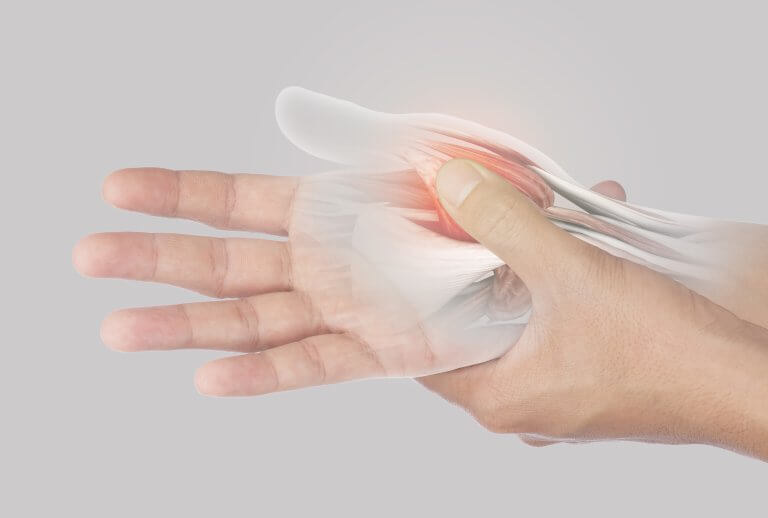
Common Hand and Finger Problems from Device Overuse
- Carpal Tunnel Syndrome Carpal tunnel syndrome occurs when the median nerve in the wrist is compressed. This compression leads to numbness, tingling, and weakness in the hand and fingers, making everyday tasks like typing and holding objects difficult. Constant use of a computer mouse or typing can exacerbate this condition.
- Trigger Finger Trigger finger is caused by inflammation in the tendons of the fingers, leading to pain and stiffness. You may experience a locking or clicking sensation when trying to bend or straighten your fingers, particularly after prolonged gripping, such as holding a phone for extended periods.
- De Quervain’s Tenosynovitis Often referred to as “texting thumb” or “gamer’s thumb,” De Quervain’s is the inflammation of the tendons around the base of the thumb. This condition causes pain when gripping, twisting, or turning your wrist, making it uncomfortable to hold a smartphone or use a mouse for long periods.
- Texting Thumb Texting thumb, also known as gamer’s thumb, is a form of tendinitis caused by the overuse of the thumbs during texting or gaming. Repeated scrolling or typing motions can inflame tendons, leading to pain, difficulty moving the thumb, and a reduced range of motion.
- Mouse Elbow Similar to tennis elbow, mouse elbow refers to the inflammation of tendons in the forearm from repetitive mouse use. This can cause pain that radiates from the elbow to the hand, affecting your ability to grip and move your fingers.
- Cubital Tunnel Syndrome Cubital tunnel syndrome occurs when the ulnar nerve (often referred to as the “funny bone” nerve) is compressed. This compression can result in pain, numbness, and tingling in the ring and pinky fingers, which are commonly affected by extended use of a keyboard or poor posture while working at a computer.
- Repetitive Strain Injury (RSI) RSI is an umbrella term for injuries caused by repetitive motions and overuse. It manifests as pain, weakness, and stiffness in the hands, wrists, and fingers. Prolonged mouse use, excessive typing, and constant phone handling are common culprits.
- Thumb Arthritis Over time, chronic use of the thumbs for scrolling and texting can lead to thumb arthritis. This painful condition results from the wear and tear of the thumb joints and can make simple movements like holding a phone or gripping objects excruciating.
- Tendinitis Tendinitis refers to inflammation of the tendons in the fingers or wrists due to overuse. Frequent typing or repetitive scrolling motions can inflame the tendons, causing pain, swelling, and difficulty with hand movements.
- Digital Fatigue Digital fatigue occurs when the muscles in the hands and fingers are overworked from long periods of using digital devices. This leads to cramping, discomfort, and a noticeable decrease in dexterity.
Why These Problems Happen
In our modern world, we rely heavily on devices for work, entertainment, and communication. This constant use of phones and computers leads to repetitive motions, such as scrolling, clicking, and typing. When combined with poor posture, lack of breaks, and bad ergonomics, these actions put unnecessary strain on the hands and fingers.
Most of us tend to ignore early warning signs like slight pain or tingling, which can eventually lead to more serious conditions that require medical attention. The best way to address these problems is to prevent them from occurring in the first place.
How to Keep Your Hands Healthy and Your Grip Strong
Luckily, there are several ways to reduce the risk of developing hand and finger problems. By taking proactive steps, you can keep your hands healthy and pain-free while maintaining a strong grip. Here’s what you can do:
- Take Regular BreaksOne of the easiest and most effective ways to prevent strain is to take regular breaks. Follow the 20-20-20 rule: every 20 minutes, take a 20-second break and look 20 feet away from your screen. This will give your hands and fingers a rest from repetitive motions.
- Practice Hand and Finger ExercisesSimple stretches and exercises can go a long way in keeping your hands flexible and strong. Try opening and closing your fingers into a fist, stretching your wrists, and gently massaging your hands throughout the day to improve blood flow and relieve tension.
- Use Ergonomic ToolsInvest in ergonomic keyboards, mice, and phone holders that reduce strain on your hands and wrists. Look for tools that allow your hands to rest in a more natural position, minimizing the risk of repetitive strain injuries.
- Maintain Good PostureProper posture is essential for reducing strain on your hands and fingers. Make sure your wrists are aligned with your forearms when typing, and avoid awkward hand positions when using your phone or mouse. Keep your desk setup at an appropriate height and angle for comfort.
- Consider a Hand Strengthening DeviceDevices like hand and finger trainers can help strengthen the muscles and tendons in your hands, improving your grip and preventing injuries. These devices are especially helpful for people who rely on their hands for work or hobbies.
- Apply Cold or Heat TherapyIf you experience discomfort, try using cold packs to reduce inflammation or heat therapy to relax stiff muscles. These therapies can be used after a long day of typing or scrolling to relieve tension and prevent further strain.
- Stay HydratedHydration is key to keeping your muscles and joints functioning properly. Drink plenty of water throughout the day to keep your tendons lubricated and to reduce the risk of cramping and stiffness.
Take Action Today
In a world where technology is central to our daily lives, it’s easy to overlook the physical toll constant device use takes on our hands and fingers. By recognizing the early signs of strain and taking proactive steps to prevent these problems, you can keep your hands healthy, your fingers agile, and your grip strong.
If you’re looking to maintain hand strength or recover from discomfort, consider Remedic’s Hand and Finger Training Systems. Our products are designed to help you strengthen your hands, improve flexibility, and reduce the risk of injury, ensuring you stay productive without pain. Keep your hands healthy and get back to doing what you love with Remedic.
Taking care of your hands today can save you from pain tomorrow. Invest in your health and keep your hands strong with these simple yet effective tips!
- #HandHealth
- #Ergonomics
- #CarpalTunnel
- #RepetitiveStrainInjury
- #DigitalWellness
Q&A List
1. Why do my hands ache after a long day of typing on the computer?
If you spend many hours typing or using a mouse, repeated motion can strain tendons, muscles and joints in your fingers, wrists and hands. Over time this can lead to discomfort, stiffness, or swelling. Simple ergonomic adjustments and light breaks can help prevent that.
2. What is “texting thumb” or “smartphone thumb” and can it affect older adults too?
Yes — the strain caused by frequent thumb and finger movement when using a smartphone or tablet can lead to tendon irritation or “tenosynovitis.” Older adults may be more vulnerable because joints and soft tissues are already less resilient. A few minutes of rest and gentle exercises can reduce the risk.
3. How can I tell if I have a work-related repetitive strain injury (RSI) in my hand or fingers?
Common signs include: persistent hand/finger/wrist pain during or after work, tingling or numbness (especially at night or when resting), weakness in grip, fingers that feel stiff or “locked.” If you’ve done a lot of the same motion (typing, fine tool work, assembly) for months, RSI should be considered.
4. What should I do at work to reduce hand and finger strain while still getting tasks done?
-
Take short breaks every 20-30 minutes — shake out hands, stretch fingers.
-
Ensure your keyboard, mouse or tools are at the correct height and angle (so wrists are not bent uncomfortably).
-
Use ergonomic aids (e.g., padded wrist rest, lighter tools, bigger handles) to reduce force.
-
Alternate tasks when possible so you’re not using the same hand/finger motion continuously.
5. My fingers feel stiff and weak after a weekend of heavy yard work — what can I do to help recover?
-
Rest the hands for a day or two; avoid heavy gripping.
-
Use a cold pack if there’s swelling, then later switch to gentle warm-up.
-
Do simple finger stretches and grip exercises (such as squeezing a soft ball) to regain strength and mobility. (Rehabilitation guidance supports this approach.) La Clinica+1
-
If the stiffness or pain persists more than a week, see a hand therapist.
6. I’ve been diagnosed with Carpal Tunnel Syndrome — how should I manage it at work and at home?
-
At work: minimize wrist flexion/extension — keep wrists neutral, use ergonomic keyboard/mouse setups.
-
At home: Use night wrist splint if recommended, take mini-breaks during the day, perform nerve gliding or finger mobility exercises.
-
In many cases, non-surgical hand therapy (ergonomic training + exercises) is the first step. Cal/OSHA
7. What are some safe hand and finger exercises I can do at home for rehabilitation?
Here are examples:
-
Finger lift: Place hand flat on a table and lift each finger slowly, 8–10 times. La Clinica+1
-
Thumb stretch: Bend thumb across the palm to the base of the pinky, hold for a few seconds, repeat 10-15 times.
-
Claw stretch: With fingers straight, bend the top two joints into a “claw,” hold 5 seconds, then straighten. Repeat 10 times.
-
Grip squeeze: Use a soft ball or sponge, squeeze for 5 seconds, release. Do 10–15 reps. La Clinica
Always stop if you feel sharp pain and consult a therapist if unsure.
8. My hands shake or I have weak grip strength — what could be causing that?
Weak grip or tremor can come from muscle fatigue, nerve compression (e.g., carpal tunnel), arthritis, or overuse from repeated strain. In older adults, joint degeneration also plays a role. A hand therapist or physical therapist can assess whether you need strength-training, assistive devices, or ergonomic adjustments.
9. How long does it take to recover from finger strain or minor hand injury from work?
It depends on severity and how soon you intervene. Minor tendon or muscle strain from overuse might improve in a few days to a couple of weeks with rest and proper care. More serious issues (nerve compression, tendon injury, or delayed rehab) can take weeks to months. Early intervention with hand therapy helps shorten recovery. PM&R KnowledgeNow
10. What role does a hand therapist or occupational hand therapy play in workplace-related hand issues?
A certified hand therapist (or occupational therapist with hand specialization) can:
-
assess your hand/wrist condition in relation to your job tasks,
-
prescribe exercise and mobility/strength programs,
-
provide splints or braces if needed,
-
modify your workstation/tools, and
-
help prevent future injuries by teaching safe mechanics and hand usage. South Shore Orthopedics
11. Are there tools or devices that can help me reduce hand strain during work?
Yes. Tools and devices that help include: ergonomic keyboards and mice, padded or oversized tool handles, hand supports/splints for breaks, assistive aids for gripping/opening jars/buttons, and motion-tracking or reminder software to prompt breaks. Using these reduces load on the fingers and wrists.
12. I have arthritis in my hands — how do I adapt exercises and my work routine?
-
Choose gentle range-of-motion moves rather than forceful ones.
-
Use assistive opening devices (for jars/doors), larger grips on tools.
-
Incorporate rest breaks and alternating tasks.
-
Do regular low-impact strengthening to support joints.
-
Speak with your therapist about arthritis-friendly grips and hand-exercise routines.
13. When should I see a doctor or hand specialist instead of just doing rest and exercises?
See a healthcare provider if you experience:
-
sudden severe pain or swelling, inability to move a finger or wrist,
-
persistent numbness or tingling (especially at night) that affects your function,
-
loss of grip strength or hand deformity, or
-
a work-related injury that caused trauma (crush, cut, fracture) rather than just overuse. Early diagnosis leads to better outcomes.
14. Can I stay at my job while recovering from hand strain, and what modifications might help?
Often yes—with modifications. Some helpful changes:
-
shorter work periods or more frequent breaks,
-
reducing repetitive hand/finger tasks or alternating with less demanding ones,
-
adjusting workstation height/position, using padded supports, and
-
using ergonomic tools or assistive devices. Talk to your employer or occupational health about accommodations.
15. How can I prevent hand and finger strain in the future once I’ve recovered?
-
Practice micro-breaks: every 20-30 minutes, shake out your hands, stretch fingers, change task.
-
Use ergonomic ergonomics: proper keyboard/mouse height, neutral wrist position, supportive chair/desk.
-
Use assistive tools when tasks are repetitive or require fine grip.
-
Gradually increase task load rather than jumping into full-demand work after a break.
-
Keep up hand-strengthening and mobility exercises as part of your routine—even after recovery.





